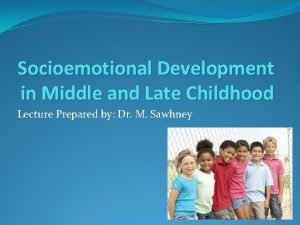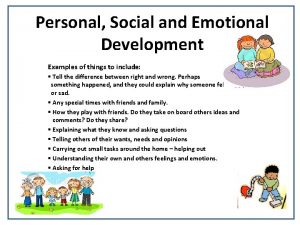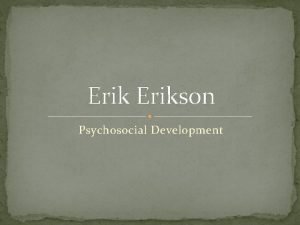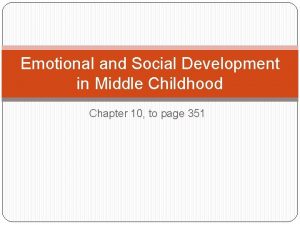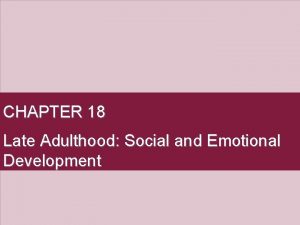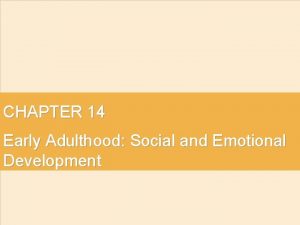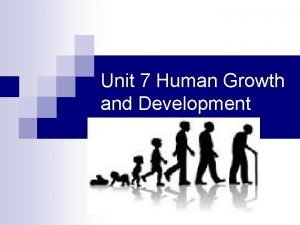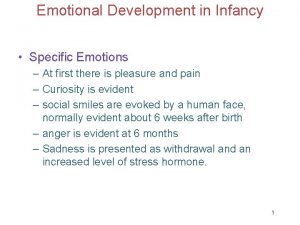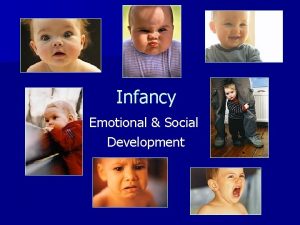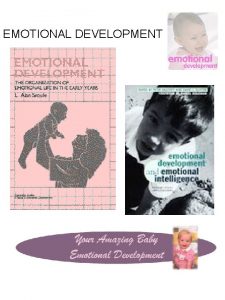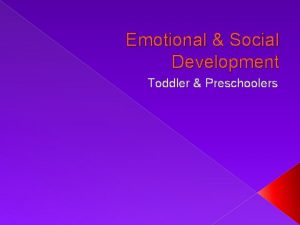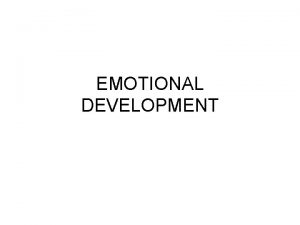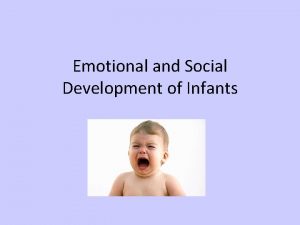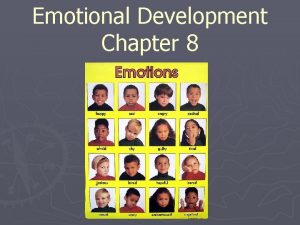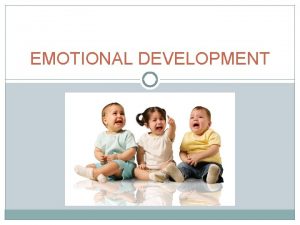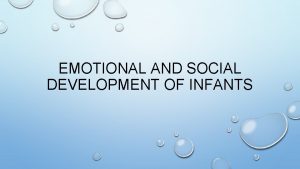Unit 5 Emotional Development Definition of Emotional Development

















- Slides: 17

Unit #5 Emotional Development

Definition of Emotional Development: § Emotional development is the start of a child's experience, understanding, expression, and supervision of emotions from birth to late youth. It also includes how growth and changes in these processes related to emotions take place.

• Emotional Development from Infancy to Adolescence

• During Early stages(Infancy) • K. M Bridges said new born babies have no discriminated emotional response but show only a generalize excitement. • By she means that specific reactions, even as response to strong motivations cannot be identified during the first week. § Only very general and uncontrolled muscles reaction can b observed.

• At 3 months excitement develops into distress and delight in this distress dominates more. • At 6 months at the negative emotions take the lead and distress develop into fear and anger. • At 12 months positive emotions enter in the field and delight is distinguished into affection. • At 18 months jealousy develops from distress and affection distinguished into affection for youth and affection for children.

During childhood Early childhood : (2 -5 years 3 -6 years) • At 24 months, delight was further discriminated and joy appears. • At 5 years (60 months) fear is discriminated into shame and stress. • Anger is again discriminated in to disappointment and jealousy. • From delight hope is again discriminated.

Emotional Characteristics of Learners

Preschool and playgroup. • Age: 3 -5 years. • Children tend to express their emotions freely and openly, with anger bursts being frequent. • Jealousy among classmates is fairly common as these children tend to have much affection for their teacher and actively seek approval. • Children laugh when others laugh.

• Primary Level • Age: 6 -8 years. § Children are sensitive to reproach and laughter may have difficulty adjusting to failure. • Most children are eager to please the teacher. • Children become sensitive to the feelings of others

Elementary Level • Age: 9 -10 years. • Worries related to school performance. • Sense of humor expressed in practical jokes, and nonsense word. • Discrimination between good and bad but still immature • Self-image composed of self-description, self-esteem, and self -concept.

Secondary Level • Age: 11 -13 years. • View of youth as a period of “storm and stress” is larger-than-life. • Some students experience nervousness, low self-esteem, and depression. • Students are often self-conscious and self-centered as a result of the nonstop influence of selfish thought.

• Higher Secondary Level • Age: 14 -17 years. • Many disorders also appear or become prominent during youth. • The most common type of emotional disorder during youth is depression.

• Role of Teacher in Emotional Development • Emotionally balanced • Understands the individual needs of the children. • Be able to deal with all sorts of emotions (anger, sadness, happiness) • Find out ways to motivate children.

Emotionally Balanced: • A teacher should know how to handle her emotions first, and then only she’ll be able to deal with young kids. • She should give love, care and affection to the children deserve. • The teacher in the schools is a role model for the children.

Understands the Individual needs of the Children • Each child is gifted with a different ability and different need. • It is up to a teacher to identify the child because some child can be reserve , some social, some with high IQ level and some with low IQ level. • The teacher should encourage their participation and attention. • The teacher should identify and encourage different needs and talent of the students.

Be able to deal with all sorts of emotions • The teacher should be sensitive enough to recognize the everyday emotions of a child. • Suppose a child is sad then her love and affection or by talking or involving in some fun activities she should be able to bring her/his back. • Happy child can be asked about her happiness and can be shown to others so that they learn that it is good being happy. • Making them feel about the various emotions in role play.

Find out ways to motivate children • Children should be encouraged and admired in various incentives like giving stars on their hands, giving special awards, using daily behavior charts but for it the teacher should have clearly identified the positive behaviors that she will put on the chart. • It is important that these behaviors be explained clearly. It needs to be demonstrated and rehearsal. • For example when a student was tying the tie of another student, the teacher made all the children to stop doing what they were doing and displayed them what those two students were doing. then she took their names, explained what a wonderful way it was to help a friend asked the class to clap for them and pasted shimmering stars on the back of their hands. " so in this way children got motivated.
 Emotional development meaning
Emotional development meaning Unit 6 review questions
Unit 6 review questions Chapter 5 lesson 4 mental and emotional problems
Chapter 5 lesson 4 mental and emotional problems Middle and late childhood symbol
Middle and late childhood symbol Fictional character names
Fictional character names Late childhood
Late childhood Autonomy vs shame and doubt example
Autonomy vs shame and doubt example Middle childhood emotional development
Middle childhood emotional development Social development middle adulthood
Social development middle adulthood Emotional development for early adulthood
Emotional development for early adulthood Emotional development for late adulthood
Emotional development for late adulthood Social and emotional development in late adulthood
Social and emotional development in late adulthood Emotional development for early adulthood
Emotional development for early adulthood Social development in adulthood
Social development in adulthood Emotional changes in late adulthood
Emotional changes in late adulthood New emotions that appear toward the second year
New emotions that appear toward the second year Chapter 8:1 life stages
Chapter 8:1 life stages What is emotional development
What is emotional development



